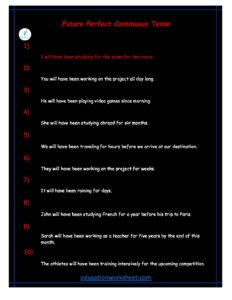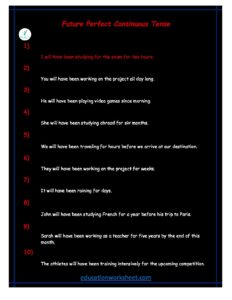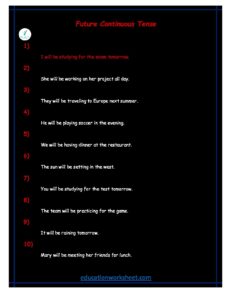how to converting Future Continuous Tense positive sentences to negative form
how to converting Future Continuous Tense positive sentences to negative form
The English language is a dynamic and versatile tool, allowing us to express a wide range of thoughts, ideas, and actions. Tenses play a crucial role in shaping our language, and one of the most commonly used tenses is the Future Continuous Tense. In this article, we will explore how to convert Future Continuous Tense positive sentences into their negative forms. By doing so, you will gain a deeper understanding of English grammar and enhance your communication skills.
Understanding Future Continuous Tense

Before we dive into transforming positive sentences into their negative counterparts, let’s take a moment to understand the Future Continuous Tense. This tense is used to describe actions or events that will be ongoing at a specific point in the future. It is often formed using the auxiliary verb “will” or “shall” followed by “be” and the present participle of the main verb (the base form with “-ing” added).
For example, in a positive Future Continuous Tense sentence, you might say, “I will be studying at the library tomorrow.” In this sentence, “will be studying” is the Future Continuous Tense construction, indicating an action that will be in progress at a specific future time (tomorrow).
Converting Positive to Negative

Now, let’s explore how to convert positive Future Continuous Tense sentences into their negative counterparts. When negating a Future Continuous Tense sentence, you typically need to add “not” after the auxiliary verb “will” or “shall.” This effectively turns the positive sentence into a negative one.
Let’s take our previous example and convert it into the negative form:
Positive: “I will be studying at the library tomorrow.” Negative: “I will not be studying at the library tomorrow.”
In this example, “will not” is used to negate the action of studying in the future. The sentence now conveys that the speaker will not be engaged in this activity tomorrow.
Additional Notes on Negative Form
- Contracted Forms: In everyday conversation and writing, it’s common to use contracted forms to make negative Future Continuous Tense sentences more concise. In the example above, “will not” can be contracted to “won’t.” So, the negative sentence would read, “I won’t be studying at the library tomorrow.”
- Auxiliary Verbs “Will” and “Shall”: When converting sentences to the negative form, remember that both “will” and “shall” can be used to create Future Continuous Tense sentences. For example, you can say, “I shall be working late tonight,” and to make it negative, you would use “shall not” or the contracted form “shan’t” as in, “I shan’t be working late tonight.”
- Placement of “Not”: In English, “not” is typically placed after the auxiliary verb “will” or “shall.” However, you can also use the contracted form “won’t” or “shan’t” to simplify the sentence further.
- Subject-Verb Agreement: The conversion of positive to negative does not affect the subject-verb agreement. The present participle form of the verb remains the same, as it always takes the “-ing” ending. For instance, in the sentence, “She will be singing at the concert,” the negative form becomes, “She will not be singing at the concert.”
- Adverbs of Time: When negating Future Continuous Tense sentences, you can still include adverbs of time to specify when the action will not take place. For example, “I will not be working on the project tomorrow,” or “They won’t be traveling to Paris next week.”
Common Negative Contractions
In casual conversation, English speakers often use contractions to make sentences flow more naturally. Here are some common contractions you can use when forming negative Future Continuous Tense sentences:
- “Will not” → “Won’t”
- “Shall not” → “Shan’t”
- “Cannot” → “Can’t”
- “Do not” → “Don’t”
- “Does not” → “Doesn’t”
- “Is not” → “Isn’t”
- “Are not” → “Aren’t”
- “Am not” → “Aren’t”
- “Has not” → “Hasn’t”
- “Have not” → “Haven’t”
- “Had not” → “Hadn’t”
Using contractions not only simplifies your sentences but also makes your spoken English sound more fluent and natural.
Practice Makes Perfect
Converting Future Continuous Tense positive sentences to negative form may seem straightforward, but like any aspect of language, it becomes more natural with practice. It’s essential to engage in conversations, write sentences, and try various examples to become proficient in using this grammatical structure.
To further your understanding, let’s work through a few more examples of positive Future Continuous Tense sentences and their corresponding negative forms:
- Positive: “They will be watching a movie this evening.” Negative: “They will not be watching a movie this evening.”
- Positive: “I shall be cooking dinner at 7 o’clock.” Negative: “I shan’t be cooking dinner at 7 o’clock.”
- Positive: “She will be running a marathon next month.” Negative: “She won’t be running a marathon next month.”
- Positive: “He will be taking a break in an hour.” Negative: “He will not be taking a break in an hour.”
Remember that while “will” and “shall” are used to express future events, the negation is achieved by inserting “not” or its contracted form “won’t” or “shan’t.”
Using the Negative Form in Practice
Now that you have a grasp of how to convert positive Future Continuous Tense sentences into negative ones, it’s important to know when to use this form in practice. Here are a few common situations where you might use the negative Future Continuous Tense:
- Expressing Absence: You can use negative Future Continuous Tense to indicate that something will not be happening in the future. For example, “I won’t be at the meeting tomorrow” suggests that your absence is expected.
- Making Plans: When discussing future plans that you do not intend to carry out, you can use the negative form to convey this. For instance, “I won’t be going to the party on Friday” implies that you have no intention of attending.
- Predicting Outcomes: Negative Future Continuous Tense can be used to make predictions about what will not happen in the future. “She won’t be passing the exam if she doesn’t study” implies a negative outcome if no action is taken.
- Expressing Preferences: You can use the negative form to express your preferences. “I won’t be going to the beach; I’d rather go hiking” indicates a preference for one activity over another.
- Refusing Offers or Invitations: If you want to politely decline an invitation or offer, you can use the negative Future Continuous Tense. For example, “I won’t be coming to the party, but thank you for the invitation.”
- Talking About Impossibilities: When you want to highlight the impossibility of a future event, you can use the negative form. “He won’t be finishing the project in one day; it’s too complex.”
how to converting Future Continuous Tense positive sentences to negative form


